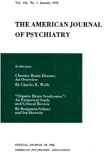THE EFFECT OF ANOXIA AS MEASURED BY THE ELECTROENCEPHALOGRAM AND THE INTERACTION CHRONOGRAM ON PSYCHONEUROTIC PATIENTS
Abstract
1. Observations on the effect of breathing low oxygen are reported in a series of 67 patients and 42 controls, in whom changes in central nervous system activity were measured by the EEG and changes in behavior by the interaction chronogram.
2. Most subjects showed a shift in EEG to the slow frequencies during low oxygen. This was more marked and consistent when the CO2 was less than .3%. There was no difference between patients and controls.
3. A decrease in verbal and gestural activity was found in about three-fourths of the subjects. The decrease was greater for the patients than the controls.
4. Subjects with high initial activity while breathing air showed the greatest decrease as a result of low O2. Subjects with low activity rates in air showed slight decreases and, in many instances, an increase.
5. Subjects with marked changes in EEG tended to show an increase in activity.
6. Four factors are discussed as playing a rôle in determining the changes in activity due to low O2.
(a) Initial rate of activity.
(b) Diagnosis.
(c) Electroencephalographic changes.
(d) Autonomic activity as measured by heart rate.
Access content
To read the fulltext, please use one of the options below to sign in or purchase access.- Personal login
- Institutional Login
- Sign in via OpenAthens
- Register for access
-
Please login/register if you wish to pair your device and check access availability.
Not a subscriber?
PsychiatryOnline subscription options offer access to the DSM-5 library, books, journals, CME, and patient resources. This all-in-one virtual library provides psychiatrists and mental health professionals with key resources for diagnosis, treatment, research, and professional development.
Need more help? PsychiatryOnline Customer Service may be reached by emailing [email protected] or by calling 800-368-5777 (in the U.S.) or 703-907-7322 (outside the U.S.).



